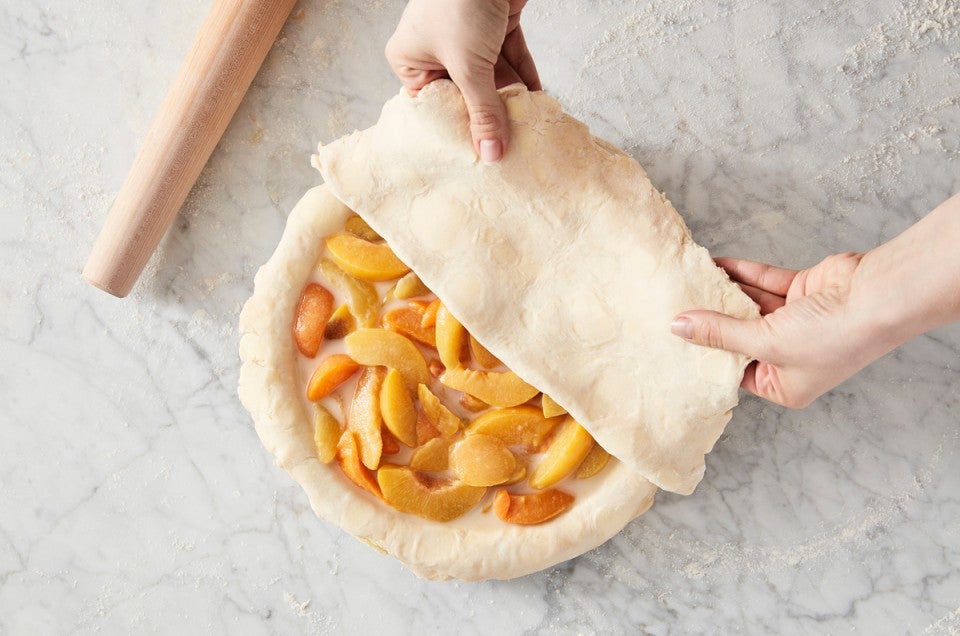


Do you suffer from pie crust phobia? If so, you’re not alone; plenty of otherwise confident bakers find themselves furtively hustling a ready-made crust out of the supermarket freezer case into their shopping cart. But life doesn’t have to be that way; you can make the best pie crust ever by following these simple steps:
We’ve written plenty about pie crust technique; our Perfect Pie Crust guide is a wealth of practical information, including links to foolproof recipes.
What I want to emphasize here is the importance of your ingredients: specifically flour, salt, fat, and liquid. Choosing those four ingredients wisely will lead to consistently great pie crust.
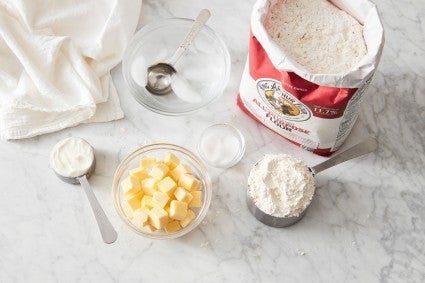
What kind of flour makes the best pie crust?
Well, not high-protein bread flour! Use that for your chewy bagels. What you want for pie is flour that yields a tender, flaky crust, which means medium-protein all-purpose flour or low-protein pastry flour.
When you add water to flour some of its protein turns into gluten, an elastic substance that gives baked goods the structure they need to hold together (and to rise when appropriate). The higher the protein level, the stronger the structure. (Learn more here: Protein percentage in flour: Why it matters.)
Strong structure in yeast bread translates to high-rising; but in pie crust, strong structure can be perceived as tough — the last attribute you want applied to your apple pie. So stick to flour with a medium-to-low percentage of protein, which means all-purpose flour (11.7% protein), pastry flour blend (10.3%), or pastry flour (8.0%).
Not necessarily. Yes, you can make tender, flaky pie crust with pastry flour. But it can be a bit of a challenge, particularly for those uncertain of their pie crust skills. Pastry flour pie crust is harder to roll without cracking, and it can split apart at the seams while the pie is baking.
That’s why I choose all-purpose flour for my pie crust. The dough is easier to roll out and move around and, despite its slightly higher protein, the crust is wonderfully flaky. In my book, the ease of an all-purpose flour crust trumps the marginal added tenderness of a pastry flour crust.
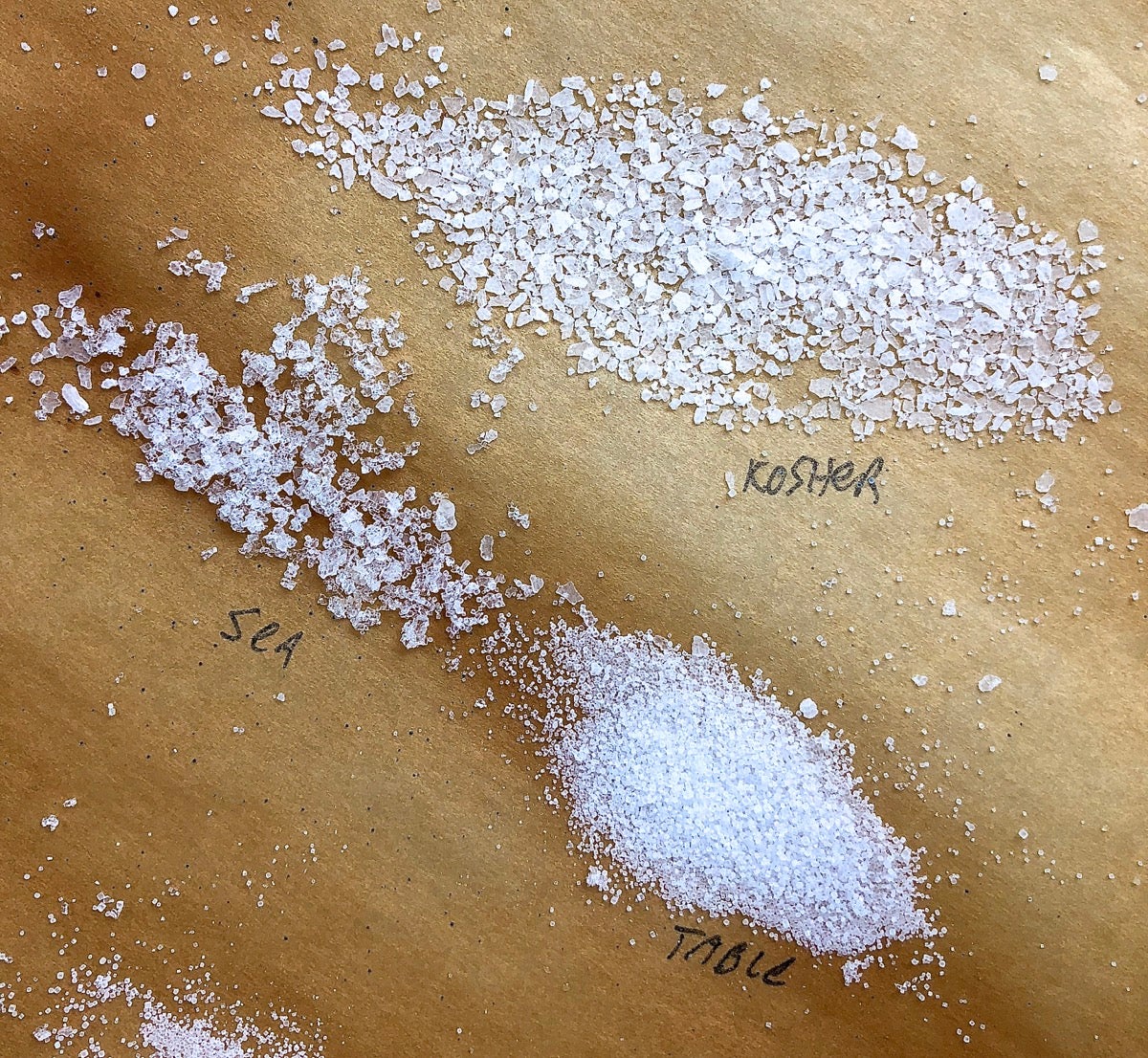
Salt adds flavor to pie crust. Leave out the salt and, unless you’re used to following a salt-free diet, the crust will taste like cardboard.
I find that when using unsalted butter and/or shortening in your crust, about 1/2 teaspoon salt per cup of flour is just perfect. If you're using salted butter, reduce the amount of added salt in your crust by 1/4 teaspoon for each 8 tablespoons (1/2 cup) of butter in the recipe.
Now, which salt is best? Kosher, flaky sea salt, table salt, or fine salt?
Since pie crust dough has very little liquid, choose table salt or fine salt. Their finer crystals will disperse more evenly throughout the dough despite the lack of water to dissolve them.
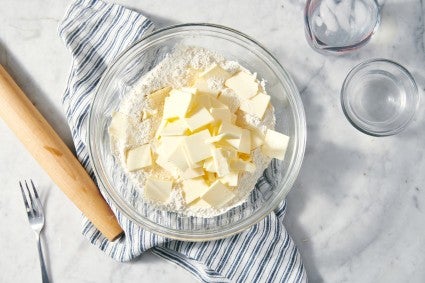
Some people love lard in pie crust. Others use liquid vegetable oil. There are those who swear by their grandma’s Crisco crust — and other bakers who eschew solid vegetable shortening for health reasons. Many people love an all-butter crust. And then there’s coconut oil … So many choices!
The best fat for pie crust? All will work, so it’s flavor preference and your own dietary choices. I alternate between an all-butter crust and one that’s part vegetable shortening, part butter.
Why the combination? Butter is a major flavor enhancer, but its low melting point can be an issue. Shortening, with its higher melting point, adds stability to a baking pie crust.
If you have trouble with your crust slipping down the sides of the pan, or if your carefully fashioned crimp around the edge melts and puddles, blame butter. A combination of butter and shortening yields the best qualities of each: flavor and baking stability.
Want to learn more about these two fats? See Butter vs. shortening: the great pie crust bakeoff.
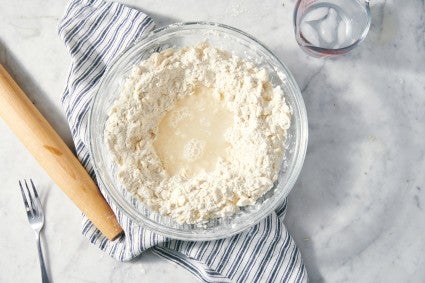
As mentioned before, liquid + the protein in flour = gluten. And once that gluten forms, working it — by mixing the pie crust dough, then rolling it out — increases gluten’s strength and decreases the resulting crust’s tenderness.
The best pie crust is a perfect balance between fat, flour, and liquid. Too much fat and the crust may taste greasy and crumble as it bakes. Too much liquid can create extra gluten, leading to tough, chewy crust.
But strike just the right balance — sufficient fat for tenderness without greasiness, and just enough liquid to hold everything together — and you’ve struck pie crust gold.
Some bakers use milk or buttermilk in their pie crust. Thanks to their milk solids, both will help crust brown and add a bit of tenderness.
But the classic liquid in pie crust is water — ice water, to be precise.
Why ice water? Ice water keeps the bits of fat in the dough cold and intact (rather than melted and dispersed). This creates little pockets of fat that, as the pie bakes, gradually melt and form tiny caverns in the crust — which we describe as flakiness.
Vodka in pie crust has been a popular substitute for ice water in recent years. Why? It’s said that its lower percentage of water (alcohol is part water, part ethanol) means less gluten development, yielding a more tender crust.
In my experience this is partially true; using vodka in pie crust makes a soft, silky dough that’s lovely to roll out. But the resulting crust isn’t any more tender or flaky than an ice-water crust.
And crust whose liquid is 100% vodka can border on being too tender, since less of its gluten has been activated. An all-vodka crust (especially one made with higher-proof vodka) can occasionally fall apart as you move it from countertop to pie pan.
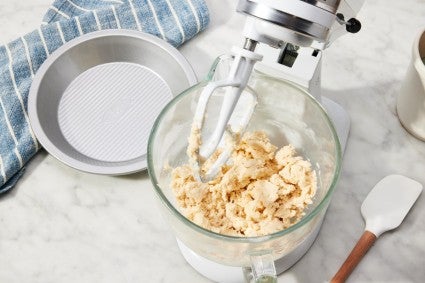
Less is more: The less liquid you add to pie crust dough (within reason), the more tender it will be.
Here’s my preferred way to add just enough liquid to pie crust. I typically make our Classic Double Pie Crust recipe (because if you’re making pie crust, you might as well make a double — you can always freeze one for later).
Once the fat, flour, and salt have been combined in my stand mixer (yes, my stand mixer; it’s easy and effective for making pie crust), I add a “nip” of vodka. You know, one of those little 50-ml. bottles.
When the vodka is thoroughly dispersed, I dribble in ice water just until the dough starts to come together. And I mean just enough water. Watch carefully as you stir; when the dough starts to clump, and you grab a handful and squeeze it and it doesn’t crumble into pieces, stop adding water.
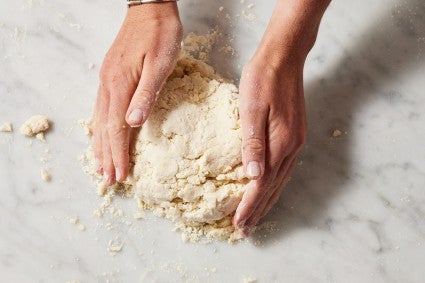
Gather the dough into a ball. Divide it in half, and flatten each half into a hockey puck-like disk.
That’s it. You’re done. You’ve just made the best pie crust for apple pie, pumpkin pie, [name your favorite] pie. Given correct handling (and you can check our pie crust guide for tips), your crust will be tender and flaky, golden brown and flavorful.
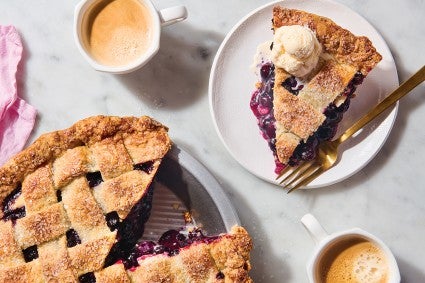
Still doubtful? Gather your ingredients and give our Classic Double Pie Crust a try. I doubt you’ll be heading back to the supermarket freezer case anytime soon!
Cover photo by Mark Weinberg.



March 13, 2021 at 4:07pm
In reply to Flour is evil. Like, active… by Bob McCarty (not verified)
I was pleasantly amused by the hyperbolic humor Bob! I too have felt like that many times during my journey to becoming a half decent home baker, but my love of cake is too strong to resist the evils of flour...
April 3, 2021 at 2:13pm
In reply to Flour is evil. Like, active… by Bob McCarty (not verified)
I love Bob's comments. I too have a love/hate relationship with flour. I actually found a baker on line, who was showing how to make pie crust, say "never show fear to the flour, if you show fear, it will defeat you." So I say to Bob; Don't show the flour that you are afraid! Are my crusts getting better? I'm working on it, but now I'm much more willing to keep trying.
June 21, 2022 at 6:30am
In reply to Flour is evil. Like, active… by Bob McCarty (not verified)
I read your article and love the insight. I agree- flour is a wildcard for sure. Took me two years to master sourdough. ‘Master’ means I’m not feeding the local bird population with 50% of what I make. I’m down to 10%. For sourdough, getting that protein percentage correct is the difference between a hockey puck and a well formed loaf and that last forming step- the tensioning- was the challenge. Too much tensioning cracks the gluten matrix. Too little causes a flat loaf. So ‘feel’ is important. Not very quantifiable. Flour is most definitely evil! As Churchill said…’Never give in’. 😄
July 13, 2023 at 10:18pm
In reply to I read your article and love… by Sal Del’Re (not verified)
Please don't feed your baking failures to the birds. It's bad for them
July 15, 2023 at 3:04pm
In reply to Please don't feed your… by Marie (not verified)
Thanks for this reminder, Marie!
June 24, 2023 at 12:52pm
In reply to Flour is evil. Like, active… by Bob McCarty (not verified)
Haha. I feel your pain and like anything in life the best things sometimes come at a price my friend. And as I can tel in your tone this is one hell of a battle. I too have this barrier in my heart and although long in the tooth and well versed in most baking skills dough remains an elusive muse like the ones calling sailors to their demise. But it’s a journey and these tops will ease that a bit. By gettting rid of some of the problem inputs that create variation, you are able to focus on the ones you can’t control as easily. Like technique and knowing what the heck it’s suppose to look and feel like if you don’t know how to get past a giant mess of sticky dough and no hands left to touch anything remotely helpful you x rot maybe your auto 911 dialer as you fall trying to reach the fire hose. Dealing with dough has so many elusive “magic” feely inputs and eliminating a few of them by getting these 4 items dialed in at least, then it starts to clear the horizon a little bit. But I still have not crossed that desert to the emerald city of pie crust. I still make a mess and will not get close to th e ease that tv hosts show with their premeasured items all at hand at the perfect temp and just in time. And the clean aprons d counter always make me laugh. I guess when you have commercials and a staff…well.
But inch by inch and tweak the variation as you go. 😋
February 22, 2020 at 7:59am
I'm looking for a guide on various techniques to decorate my pie crust. I want a showy "wow" crust that's Fair Comparative worthy. I enter & have won 1st place (w/your recipe-Thank you) the past 3 years!! If you provide said blog, could not find it.
Thank you, Jessie via NC
February 24, 2020 at 2:57pm
In reply to I'm looking for a guide on… by Jessie Norris (not verified)
Jessie, congrats on your outstanding pie crust wins! If you're looking for more decorative techniques to wow a crowd, our Fancy pie crust blog post and Decorative pie crust tips blog post are both great places to start. For an unorthodox but no less showstopping variation, you might also want to give our Cinnamon bun apple pie a try! Happy baking!
December 3, 2019 at 1:32pm
Hi, Your blog is very helpful so I'm hoping that you can help me. For the first time in 40 years, I'm having trouble with my pie crusts. My crusts are coming out more like bread than pie crust, and there's lots of melted butter in the sheet pan below. I'm beginning to suspect my new Wolf oven which, hard as it may be to believe, may be running cool. My last 10 pies have been a disaster, despite my trying new recipes, using less water, weighing my flour, etc. Can you please help me? What happens to crust that is baked at too low a temperature? Thank you.
December 3, 2019 at 5:06pm
In reply to Hi, Your blog is very… by Hetty King (not verified)
That must be so frustrating, Hetty! The butter is essentially melting before the water in it can create steam and cause the crust to rise up with flaky layers and begin to set. If you can get an oven thermometer you can adjust the thermostat so so you can get it to the correct internal temperature until it can be recalibrated.
Pagination